 |
|

What is the origin of Buddha and Buddhism

Buddha was born 2500 years ago, in the Sakya family, in India.
The name of his father was Cetzangma and his mother was called Kjuma Hlatze.
When he was still young, he learned about the ten sciences.
Because a number of kings were fighting over princess Satsoma, her father decided that the kings should show their skills through archery and other skills. The Buddha had the best skills and princess Satsoma became his wife.
She gave birth to a child named Dachanzin.
The circumstances within the palace were acceptionally beautifull.
However when the Buddha left the palace, he was confronted with the elements of suffering, such as birth, sickness, old age and death. He thought a lot about how he could end this suffering.So he decided to leave his kingdom, his wife, child and belongings, to become a monk.
He practiced many austerities, and practiced a lot of analyses and meditation.Advengeally, he attained perfect Buddhahood under the Bhodi tree, in Bodh Gaya.
Usually, we talk about the twelve deeds of the Buddha, one of which was the attainment of enlightenment. These comprise the life of the Buddha.
After his attainment of enlightenment, he was motivated by love and compassion. It became clear to him, that all living creatures were in the same situation, and wanted to be liberated of suffering. It is possible to attain enlightenment, for every living creature.
The Buddha saw that all beings carry the essence of enlightenment in them, and through effort, can attain enlightenment.
Buddha's teaching
In Varanasi Buddha taught his first lesson about the four noble truths, also known as the first turning of the Dharma-wheel.
The first time Buddha taught the Dharma, there were five monks present.
These were the first five monks that Buddha meditated with.
Buddha gave many teachings: first the general teachings called “the Hinayana” (the small vehicle) and then the Mahayana (the great vehicle) teachings. And also, in secret, he taught the Tantric teachings to his students with sharp faculties.
In general, it is said that the Buddha eighty-four thousand teachings, adapted to the individual capacities of his students.
Twenty-one thousand ways of the three poisons: aversion, attachment and ignorance
Twenty-one thousand ways of the poisons together
The three pitakas, (baskets) Abhidharma, Vinaya and Soetra, Hinayana scriptures
One basket of tantra.
The Buddha has taught many students, of which the sixteen arhats are concidered the most important, like Shariputra and Mangalpu. After he had past on, other great teachers, such as Nagaryuna, Asanga and Aryadeva, arose.
In Buddhism, we talk about the six ornaments and the two superiors. These eight teachers all studied at the Nalanda-university.
Not only was Nalanda the biggest university, but it also brought forth the greatest scientists. There unimagionably many commentaries written about the teachings of the seventeen Nalanda masters.
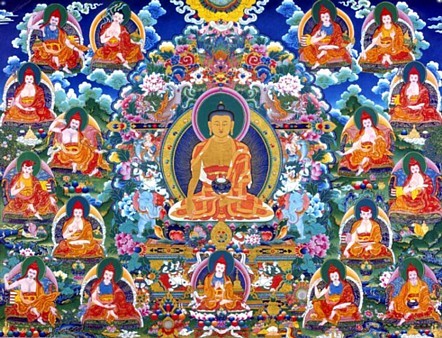 Buddha Shakyamuni and the seventeen Nalanda perceptors
Buddha Shakyamuni and the seventeen Nalanda perceptors
Seventeen Nalanda Masters
These great Indian Pandits were connected to the Nalanda Monastery :- Nagarjuna Buddha Shakyamuni and the Seventen Nalands masters
- Aryadeva
- Buddhapalita
- Bhavaviveka
- Chandrakirti
- Shantideva
- Shantarakshita
- Kamalashila
- Asanga
- Vasubandhu
- Dignaga
- Dharmakirti
- Arya Vimuktisena
- Haribhadra
- Gunaprabha
- Shakyaprabha
- Atisha
In the end of a prayer, H.H. the Dalai Lama refers to these seventeen masters:
“These days the whole world is witness to enormous progress in the areas of science and technology but at the same time, we are being distracted by the issues of the day.
It’s of crucial importance that we follow the Buddha, to develop faith that is based on the insight from the Buddhist Dharma teachings.
It is important we investigate and analyze our insights. A unbiased and interested mind is prerequisite in this.
When we develop faith, based on insight, the excellent works of the Profound and elaborate traditions of the masters of essential meaning. These are universally known as “the Six Ornaments and the Two Exalted Masters”, as well as others, such as Buddhapalita and Arya Vimuktisena.
Because of this, H.H. the Dalai Lama gave order to paint a Thangka of the seventeen highest educated and learned masters of Nalanda.
This, with nine other masters of the profound and elaborate lineages of the traditional Thangka-sequence, on behalf of the “Six Ornaments and the Two Exalted Masters”.
Also, there were eighty Siddha’s, who were perfect masters.
The history of Tibatan Buddhism
Guru Padma Jungné

The seventh emanation of Guru Rinpoché is called Padma Jungné. According to the biography of Guru Rinpoché, six emanations appeared outside Tibet. It is difficult to place these stories in a lineair structure, because Guru Rinpoché’s wisdom activities are’nt limited by time and space. Traditionally, these emanations appeared within the borders of Tibet.
The first time Buddhism cam to Tibet, was around the end of the fourth century and the beginning of the fifth century.
Around that time, a number of Mahayana –scriptures, a golden stupa, and a tsa-tsa mold were found on the roroyal palace of Yum-bu Bla-sgang in Yarlung. Tsa-tsa molds are being used to make little stupas, made out of dough, of which eight can be stacked together, so they comprise a bigger stupa.
According to some reports, the twenty-eighth ancestrial king of Tibet, Lha-Tho-Tho Ri, when he was sixty years old, he took a walk across the roof, when these descended from the sky. This was the beginning of the fifth century, and the palace is seen as the first building in Tibet. Before that, most people would live in tents and caves. There still is a monument on the place where the palace has stood, all though the ruínes have been destroyed completely during the Chinese cultural revolution. Supposeably, recently these ruines have been restored in the original style.of of the royal palace of Yum-bu Bla-sgang in Yarlung. Tsa-tsa molds are being used to make little stupas, made out of dough, of which eight can be stacked together, so they comprise a bigger stupa.
His lessons have been studied by Kadampa Buddhists world-wide. They strive to follow his pure exampleDe zevende emanatie van Goeroe Rinpoché wordt Goeroe Padma Jungné genoemd.
Nyingmapa traditie.
After the seventh century, a Tibetan king ruled, called Trisong Deutsen.
He got the Indian masters Bodhisattva and Shantarakshita to Tibet to build a monastery. But after this monastery was build, during the night it was torn down by the local spirits and demons. Shantarakshita advised the king tos end for Padmasambhava, to ask him to come to Tibet, so he could perform a powerful puja. This would make sure the monastery would be build perfectly, without it being destroyed again.
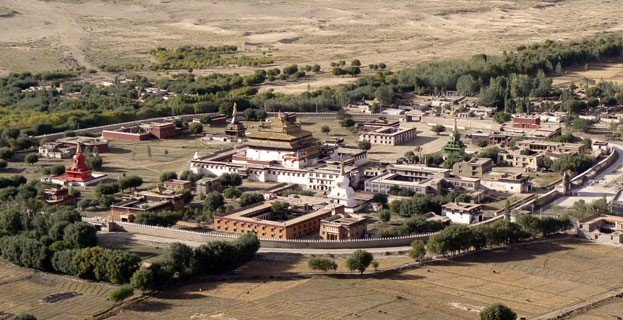 Samye monastery
Samye monastery
Seven chosen monks received the teachings from Shantarakshita, on basis of the Buddhist philosophy.
The great Yogi, Padmasambhava, Guru Rinpoché, gave the Tantric teachings to twenty-five students, as well as the king Trisong Deatsen, in the same period.
Many erudite people came to the Samye-monastery on request of Padmasambhava and king Shantarakshita, to translate the three hundred buddhist scriptures. Among these are the Kangyur, the collection of the Sutra-teachings as well as the Tengyur, the translated treatises.
By the kindness and goodness of the king Trisong Deutsen, Shantarakshita and Padmasambhava, a suitable foundation has been laid for the Tbetan Buddhism.
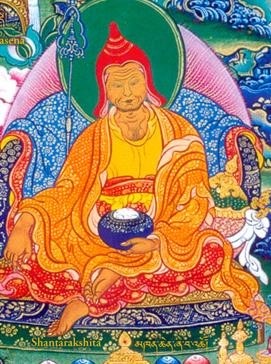
Shantarakshita
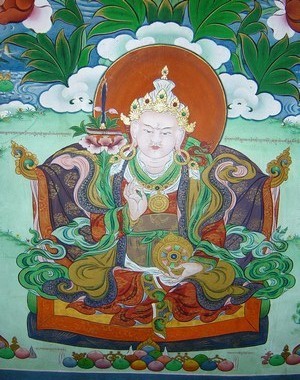
Koning Trisong Deutsen
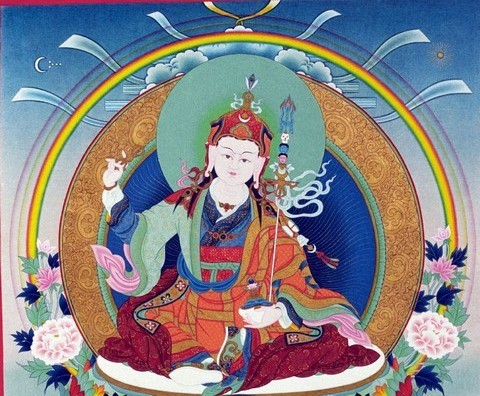
Padmasambhava
Kagyu
The Kagyu-tradition goes back to Marpa (1012-1097), also known as the Translater, (Lotsawa).
Marpa spread the Mahamudra-lineage, that was transmitted by Tilopa (988-1069) and Naropa (1016-1100). He is one of the great translators that established the tradition of the new translations (sarma).
The Sakya and the Geluk-schools also belong to the sarmaschools.
The most important student of Marpa, in Tibet, was Milarepa (1042-1123). The most important students of Milarepa were Tertön Rechung Dorje Dragpa (Rechungpa) (1084-1161),- who transmitted the biography of Milarepa-, and the monk Gampopa (1079-1153), from Dagpo.
From Gampopa, his Lamrim text, “the Jewel Ornament of Liberation” has become well known. For the Kagyuschools he developed a form of teachings, in which the monastic traditions of the earlier Kadam tradition mixed with the Yogi-tradition of the Indian masters. Because the school mainly emphasises on practice, this lineage is called “the Oral” or “perfected” school. Her power comes from the strong connection between student and teacher. Four greater and eight smaller schools can be traced back to the four main students of Gampopa.
Presently, most schools hav been merged together in the Karma Kagyü-lineage, of which the Karmapa is the spiritual leader.
Of the smaller schools, the Drugpa and Drigung have a strong following in Bhutan and Ladakh.
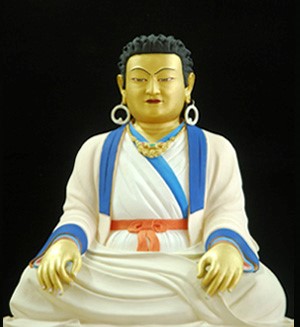
Marpa Losatwa
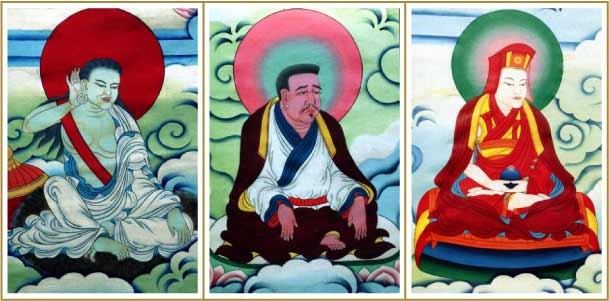
Milarepa Marpa Gampopa.
Thee Sakya tradition under Rangjung Yeshe 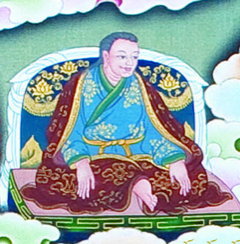
The seat of the Sakya School (Sakya), was founded in 1073, by Konchok Gyalpovan from the Khon-clan.
Her main temple, de impressive illuminating temple, (Sprul Pa’i Gtsug Lag Khang Chen Mo), was build in 1268, and is the only building, in the over a hundred buildings of the Sakya’s monastic complex, that survived the cultural revolution.
Sakya is one of the four great schools within Tibetan Buddhism, and was founded in the eleventh century by Drogmi Lotsawa (‘Brog Mi Lo Tsa Ba), a student of the Indian master Virupa
The seat of the Sakya school, Sakya was founded by Konchok Gyalpo, of the powerful Khon family, in 1073.
The Sakyatradition, of Sakyapa was formed by five masters:
- Sachen Künga Nyingpo (1092-1158)
- Sönam Tsemo (1142-1182)
- Dragpa Gyaltsen (1147-1216)
- Sakya Pandita (1182-1251)
- Phagspa (1235-1280)
Kadampa Liniage
In the ninth century, the Kadampa lineage was founded by Atisha Kadampa, and brought to Tibet.
Atisha means perfect.
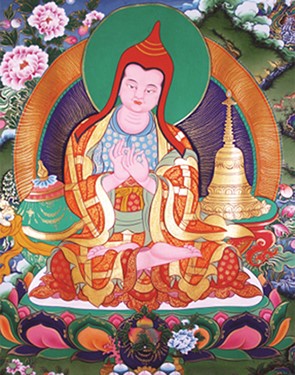
The great Buddhist master Atisha Kadampa (982-1054)was responsible for the introduction of the pure Buddhist teachings in Tibet.
Gelukpa
Gelukpa are students of the Geluk school, or lineage of Lama Tsongkhapa.
Gelukpa is one of the four main lineages of Tibetan Buddhism.
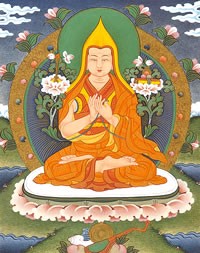
Je Tsongkhapa taught the Tibetans patiëntly all they needed to know for their spiritual development, from the first step on the path of spiritual practice, up to the ultimate result of Buddhahood.
This was a golden age in Tibet, and thousends of Tibetans were inspired by Je Tsongkhapa’s unrivaled example of pure moral discipline, a compassionate way of living and profound, liberating wisdom.
His followers were known as the “new Kadampas”, until this day.
The Tibetan Buddhism of the Nyingmapa, Kadampa, Kagyupa, and Gelukpa lineages all contain the paths of the Hinayana, Mahayana and Vajrajana (Tantra), as well as the three hundred Buddhist scriptures.




